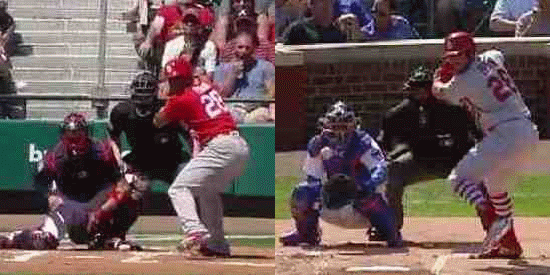This hitting diary records my work with Tommy Pham of the St. Louis Cardinals, who I worked with from August 2010 to September 2015.
Tommy ended our relationship in late September 2015 after I told him I expected to be compensated since he had reached, and was successful at, the major league level and was making $2,500 a day. He told me he didn't need to pay me because nothing I had told him had helped.
In 2016, Tommy Pham hit .226.
That was well off the .268 pace he hit for all of 2015, the .300 he hit after his second call-up in 2015 after we had fully polished his swing, and the 1.0 bWAR he put up in a single 10-day period in 2015.
Tommy then had a terrible 2017 Spring Training, hitting just a tick above .200 and looked like he was on his way out of the game. Knowing that part of the problem was pressure he was receiving from the Cardinals, and not being able to just stand on the sidelines and watch a guy's dreams die and not help him when I knew what the problem was, I sent him a series of text messages in early April 2017 that pointed out why he struggled in 2016 and continued to struggle during 2017 Spring Training.

Tommy Pham March 2017 vs. September 2017
Those texts created differences in Timing and Loading that are clearly visible, if you know what you're looking for.
And the rest, as they say, is history.
Problems
1. Inability to Hit for Average
In his first few years in pro baseball, he had a few seasons in which he hit roughly .230 and a few in which he hit no better than .200. As a result, he was unable to progress up the ladder with many of his peers.
2. Inconsistency
As with Andres Torres, we relatively quickly improved his ability to hit for average to an acceptable level. The problem was a common set of problematic cues, not anything mechanical. However, due in part to a continuing lack of power -- at the MLB level you have to hit the ball HARD just to get it past the defenses and get on base -- he was extremely streaky and was unable to put up long enough sustained runs of success to get his season average above .300 and be considered for a promotion to the major leagues.
3. Warning Track Power
When he finally made it to the major leagues, and started to do more than just ride the pine and pinch-run every once in a while, he experienced a problem with Warning Track Power; while he would hit the ball hard and for line drives, he wouldn't hit the ball hard enough for it to get into the gaps or to/over the wall for an extra base hit or home run. The result was a lot of hard-hit but hanging line-outs to the outfielders.
Root Causes
1. Linear Hand Path
Push Disconnection. Very much like Andres Torres when he first called me.
Not Loading. In truth, the opposite of Loading.
Fix = Curved Hand Path, Connection, and Rotation
Like Andres Torres, the first concept we talked about was Connection. Had to learn about the proper role of the hands and the true source of power in the swing.
2A. (Overly) Linear Lower Body
Both his hands and his stride were overly Linear.
Over-Striding and Lunging caused Problems with his Back Foot that caused him to bleed off power.
Major clue was when he told me, "When I go no-stride, I lose all my power."
Fix = Coil
Reduced linear component and replaced it with rotation and Coil.
Less Lau "You have to go back to go forward." More Williams rotation. Coil, don't lunge/leap. Reduce the linear movement and replace it with more efficient Coil and Loading.
Better back foot.
2B. Lack of a (Good) Timing Milestone
Inconsistent. Sometimes got beat by fastballs he could hit at other times.
Fix = Timing
Explained to him Jose Bautista's (actual) secret.
3. Inefficient, Top-Down Swing
Leaky Hands.
Fix = Loading the Hands
First, he didn't load his hands at all.
He then started Loading his Hands, but didn't have the Timing of his Loading right.
Fixing this problem led to huge increases in efficiency and power with little to no negative impact on average -- and likely a positive impact on average -- because he is now hitting the ball through the infielders. The ball is moving so fast, they are unable to field it cleanly, if at all.
Order of Improvements
1. Hitting for Average (Period)
We had to fix his hand path for him to be able to hit with enough power to simply get on base.
2. Hitting for Average (Consistently)
We then had to fix the lunging because it kept him from being able to hit for average with consistency.
3. Hitting for Power
The problem we fixed most recently was his Warning Track Power. We did this in part by replacing lunging with Coil. We also worked on Loading to improve his power; to get power from somewhere other than (just) his stride.
Order Concepts Introduced
I introduced my key concepts to him in the following order...
- Connection
- Rotation
- Loading
- Coil
- Adjustability
- Timing
Lingering & New Opportunities for Improvement
While he had a very good year, and delivered more than $6 million dollars worth of value as measured by WAR, in my opinion, there are a number of things he still needs to work on.
- Coil.
- Z-Axis Adjustability. More than just lunging at off-speed pitches.
- Might be a bit too far off the plate.
- New swing plane issues related to Launching the Swing that popped up during the last month of 2015.